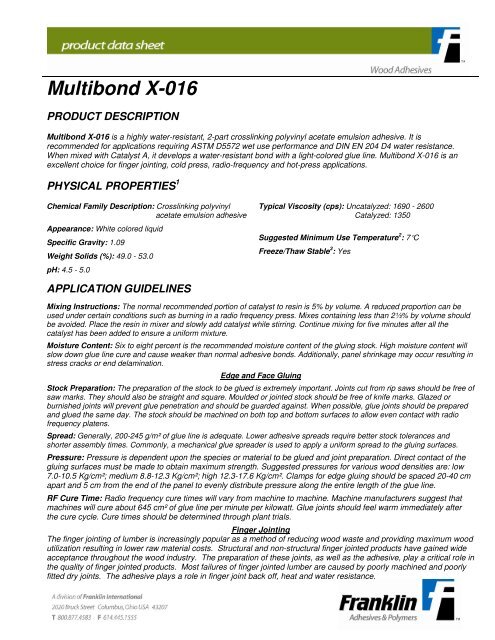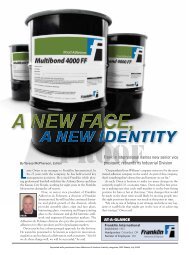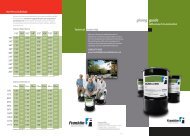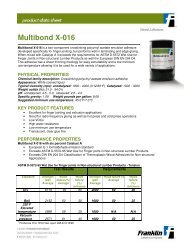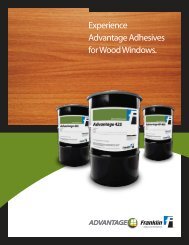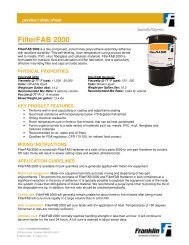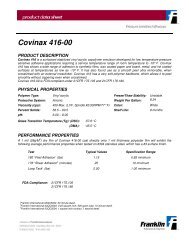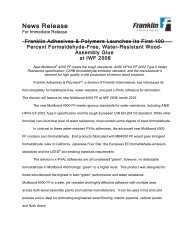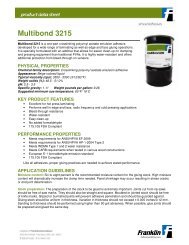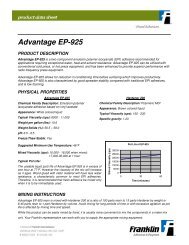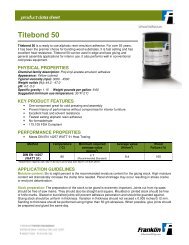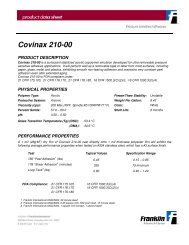Multibond X-016 - Franklin Adhesives and Polymers
Multibond X-016 - Franklin Adhesives and Polymers
Multibond X-016 - Franklin Adhesives and Polymers
Create successful ePaper yourself
Turn your PDF publications into a flip-book with our unique Google optimized e-Paper software.
<strong>Multibond</strong> X-<strong>016</strong><br />
PRODUCT DESCRIPTION<br />
<strong>Multibond</strong> X-<strong>016</strong> is a highly water-resistant, 2-part crosslinking polyvinyl acetate emulsion adhesive. It is<br />
recommended for applications requiring ASTM D5572 wet use performance <strong>and</strong> DIN EN 204 D4 water resistance.<br />
When mixed with Catalyst A, it develops a water-resistant bond with a light-colored glue line. <strong>Multibond</strong> X-<strong>016</strong> is an<br />
excellent choice for finger jointing, cold press, radio-frequency <strong>and</strong> hot-press applications.<br />
PHYSICAL PROPERTIES 1<br />
Chemical Family Description: Crosslinking polyvinyl<br />
acetate emulsion adhesive<br />
Appearance: White colored liquid<br />
Specific Gravity: 1.09<br />
Weight Solids (%): 49.0 - 53.0<br />
pH: 4.5 - 5.0<br />
Typical Viscosity (cps): Uncatalyzed: 1690 - 2600<br />
Catalyzed: 1350<br />
Suggested Minimum Use Temperature 2 : 7°C<br />
Freeze/Thaw Stable 3 : Yes<br />
APPLICATION GUIDELINES<br />
Mixing Instructions: The normal recommended portion of catalyst to resin is 5% by volume. A reduced proportion can be<br />
used under certain conditions such as burning in a radio frequency press. Mixes containing less than 2½% by volume should<br />
be avoided. Place the resin in mixer <strong>and</strong> slowly add catalyst while stirring. Continue mixing for five minutes after all the<br />
catalyst has been added to ensure a uniform mixture.<br />
Moisture Content: Six to eight percent is the recommended moisture content of the gluing stock. High moisture content will<br />
slow down glue line cure <strong>and</strong> cause weaker than normal adhesive bonds. Additionally, panel shrinkage may occur resulting in<br />
stress cracks or end delamination.<br />
Edge <strong>and</strong> Face Gluing<br />
Stock Preparation: The preparation of the stock to be glued is extremely important. Joints cut from rip saws should be free of<br />
saw marks. They should also be straight <strong>and</strong> square. Moulded or jointed stock should be free of knife marks. Glazed or<br />
burnished joints will prevent glue penetration <strong>and</strong> should be guarded against. When possible, glue joints should be prepared<br />
<strong>and</strong> glued the same day. The stock should be machined on both top <strong>and</strong> bottom surfaces to allow even contact with radio<br />
frequency platens.<br />
Spread: Generally, 200-245 g/m² of glue line is adequate. Lower adhesive spreads require better stock tolerances <strong>and</strong><br />
shorter assembly times. Commonly, a mechanical glue spreader is used to apply a uniform spread to the gluing surfaces.<br />
Pressure: Pressure is dependent upon the species or material to be glued <strong>and</strong> joint preparation. Direct contact of the<br />
gluing surfaces must be made to obtain maximum strength. Suggested pressures for various wood densities are: low<br />
7.0-10.5 Kg/cm²; medium 8.8-12.3 Kg/cm²; high 12.3-17.6 Kg/cm². Clamps for edge gluing should be spaced 20-40 cm<br />
apart <strong>and</strong> 5 cm from the end of the panel to evenly distribute pressure along the entire length of the glue line.<br />
RF Cure Time: Radio frequency cure times will vary from machine to machine. Machine manufacturers suggest that<br />
machines will cure about 645 cm² of glue line per minute per kilowatt. Glue joints should feel warm immediately after<br />
the cure cycle. Cure times should be determined through plant trials.<br />
Finger Jointing<br />
The finger jointing of lumber is increasingly popular as a method of reducing wood waste <strong>and</strong> providing maximum wood<br />
utilization resulting in lower raw material costs. Structural <strong>and</strong> non-structural finger jointed products have gained wide<br />
acceptance throughout the wood industry. The preparation of these joints, as well as the adhesive, play a critical role in<br />
the quality of finger jointed products. Most failures of finger jointed lumber are caused by poorly machined <strong>and</strong> poorly<br />
fitted dry joints. The adhesive plays a role in finger joint back off, heat <strong>and</strong> water resistance.
APPLICATION GUIDELINES (Continued)<br />
Equipment Check: Be sure to check overall knife stack for accuracy. Keep cutterheads in pairs <strong>and</strong> properly cleaned.<br />
Cutterheads should be sharpened as a set. Knife set should cut only .3 mm to .8 mm of wood. Knives should be<br />
sharpened after running approximately 70 m³ (wood species may cause this to vary). Make sure cutterhead spindle is<br />
set vertically with no wear or play in the bearings. Chain carrier lugs should be squared with the trim saws <strong>and</strong><br />
cutterheads. Make sure trim saws are set true. Check bed rails for wear on a regular basis. Check hold down pressure<br />
to provide sufficient pressure to prevent movement of stock while cutting the joint.<br />
Joint Assembly: Pressure should be held constant until joint is cured. End pressure should be set to provide 10-14<br />
Kg/cm² pressure for non-structural joints. Crowder wheels should be aligned to match fingers accurately.<br />
Adhesive Application: Sufficient adhesive spread will provide a uniform coverage that should cover 1/2-2/3 the length<br />
of the finger on both sides in a thin continuous film. Make sure fingers aren't skipped <strong>and</strong> that the adhesive is applied<br />
to the whole joint, not just the tips of the fingers. Excess adhesive squeeze-out can cause arcing in a Radio Frequency<br />
tunnel. It also causes adhesive build-up <strong>and</strong> poor adhesive efficiency. Too much adhesive can cause a hydraulic effect<br />
in finger joint back off.<br />
PERFORMANCE PROPERTIES<br />
Meets or exceeds the following industry st<strong>and</strong>ards:<br />
• NWWDA 1.S. 1-87 Type I <strong>and</strong> Type II with Catalyst A<br />
• ANSI/HPMA 1994 Type I <strong>and</strong> Type II water resistance with Catalyst A<br />
• D-5572 Wet Use (Finger Joint)<br />
• European St<strong>and</strong>ard DIN EN 204 D4 (formerly DIN 68602 B4)<br />
• European E-1 formaldehyde emission st<strong>and</strong>ard<br />
ASTM D-905 Bond Strength (hard maple) 4 lb/in² Wood failure%<br />
25°C 3,720 34<br />
65°C Overnight 1,720 05<br />
Room Temperature Speed of Set 5 : 0.74 with Catalyst A. (Very Slow)<br />
EN 204 Durability Class D4 Performance:<br />
Conditioning Sequence<br />
Minimum value<br />
<strong>Multibond</strong> X-<strong>016</strong> (6%<br />
Catalyst A) WF %<br />
1 (7 d. cure tested dry) ≥ 10 15.3 N/mm² 100<br />
3 (7 d. cure, 4 d. H 2 0 soak; tested wet) ≥ 4 7.3 N/mm² 0<br />
5 (7 d. cure, 6 hr. boiling; 2 hr. cold H 2 0: tested wet) ≥ 4 5.2 N/mm² 0<br />
6 (7 d. cure, 6 hr. boiling; 2 hr. cold H 2 0; 7 d. dry tested dry) ≥ 8 13.7N/mm² 100
HANDLING AND STORAGE<br />
Store in tightly closed original container. Protect from freezing. Storing at temperatures above 25 o C will reduce<br />
the maximum storage time. Prolonged storage will result in a gradual increase in viscosity. If thickening,<br />
separation or settling occurs, the adhesive should be thoroughly mixed <strong>and</strong> will then be ready to use again.<br />
1<br />
All numerical values represent typical properties.<br />
2<br />
Measured by <strong>Franklin</strong>’s film formation test. Gluing conditions will affect minimum use temperature.<br />
3<br />
If product has been frozen, contact Technical Service for instructions.<br />
4<br />
Performed according to ASTM D-905 on hard maple.<br />
5 Measured by <strong>Franklin</strong>’s torsion speed of set tester on hard maple @ 3 minutes clamp time. The higher the value, the faster the speed of set.<br />
IMPORTANT NOTICE TO CUSTOMER:<br />
The recommendations <strong>and</strong> data contained in this Product Data Sheet for use of this product are based on information <strong>Franklin</strong> believes to<br />
be reliable. They are offered in good faith without guarantee, as conditions <strong>and</strong> methods for use of our product by Customer <strong>and</strong> are beyond<br />
<strong>Franklin</strong>’s control. Customer must determine the suitability of the product for a particular application before adopting it on a commercial<br />
scale. Discoloration <strong>and</strong> checking of wood veneer materials may occur with use of the product. These occurrences range in appearance,<br />
color <strong>and</strong> may also vary depending upon the species of wood veneer to which the product is applied. Such discoloration <strong>and</strong> checking may<br />
appear during or after the manufacturing process which utilizes the product. Environmental conditions in some manufacturing plants <strong>and</strong><br />
end-use locations can contribute to discoloration <strong>and</strong> checking. Because such discoloration <strong>and</strong> checking are attributable to conditions<br />
beyond <strong>Franklin</strong>’s control, <strong>Franklin</strong> cannot assume any responsibility or liability for any discoloration <strong>and</strong>/or checking problems that might<br />
occur.<br />
© Copyright 2009. All rights reserved. <strong>Franklin</strong> International. Revised 10/12/09.


